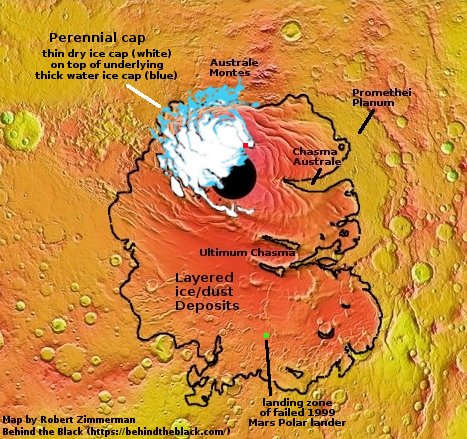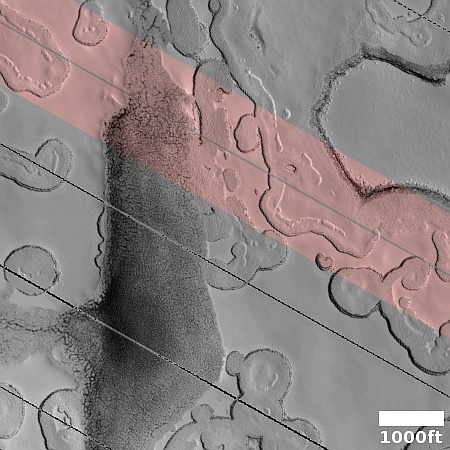The strange terrain of the Martian southern ice cap
Cool image time! The picture to the right, rotated, cropped, and sharpened to post here, was taken on July 29, 2024 by the high resolution camera on Mars Reconnaissance Orbiter (MRO). It shows a section at the Martian south pole at the very high latitude of 87 degrees south, only about 100 miles from the pole itself.
The label for this picture is “possible water ice and mesas,” suggesting we are looking at an ice cap of water that is partly sublimated away.
In truth, things are much more complicated. It was summer when this photo was taken. Note the drainage in the lower right and the dark spidery lines there. In the winter on Mars atmospheric carbon dioxide falls as snow and coats the poles to about 60 degrees latitude with a thin mantle of dry ice. In the spring this mantle sublimates away, but does so in an counter-intuitive manner. The sublimation first occurs at the mantle’s base, and the trapped gas flows up until it finds a weak spot in the mantle and cracks through, spewing out and deposting dark splotches of dust.
At the south pole this upward flow always follows the same paths, producing the dark spidery patterns we see here. In the case of the drainage in the lower right, this is a drainage of gas eastward until it pops out at the slope, causing that depression to become darkly stained.
This is only part of the story of this complex geology, however.

The red dot on the overview map to the right marks the location, close to the south pole, which in the south is comprised of several layers. On top is a small perennial cap of dry ice (indicated by white), something that does not exist in the north pole, where dry ice is generally seasonal. Below that dry ice is another cap of water ice, only slightly larger (indicated by blue). Below this is a much larger cap of mixed ice and dust, dubbed the layered deposits.
This picture shows a spot on the edge of the dry and water ice cap, and thus likely shows both permanent dry ice and water ice. That perennial cap of dry ice appears to be shrinking with time, based on images taken by MRO over the past decade. Thus, the hollows here are likely areas where the dry ice has sublimated away to reveal the water ice cap below. The circular shape of many of these hollows might reflect the buried topography below, suggesting the existence of impact craters.
All in all, this is truly alien terrain. On Earth there is no such thing as extensive sheets of dry ice. CO2 can’t survive as a solid in our warm and thick atmosphere. Thus we are seeing geological processes here on Mars that we have never seen before.
On Christmas Eve 1968 three Americans became the first humans to visit another world. What they did to celebrate was unexpected and profound, and will be remembered throughout all human history. Genesis: the Story of Apollo 8, Robert Zimmerman's classic history of humanity's first journey to another world, tells that story, and it is now available as both an ebook and an audiobook, both with a foreword by Valerie Anders and a new introduction by Robert Zimmerman.
The print edition can be purchased at Amazon or from any other book seller. If you want an autographed copy the price is $60 for the hardback and $45 for the paperback, plus $8 shipping for each. Go here for purchasing details. The ebook is available everywhere for $5.99 (before discount) at amazon, or direct from my ebook publisher, ebookit. If you buy it from ebookit you don't support the big tech companies and the author gets a bigger cut much sooner.
The audiobook is also available at all these vendors, and is also free with a 30-day trial membership to Audible.
"Not simply about one mission, [Genesis] is also the history of America's quest for the moon... Zimmerman has done a masterful job of tying disparate events together into a solid account of one of America's greatest human triumphs."--San Antonio Express-News
Cool image time! The picture to the right, rotated, cropped, and sharpened to post here, was taken on July 29, 2024 by the high resolution camera on Mars Reconnaissance Orbiter (MRO). It shows a section at the Martian south pole at the very high latitude of 87 degrees south, only about 100 miles from the pole itself.
The label for this picture is “possible water ice and mesas,” suggesting we are looking at an ice cap of water that is partly sublimated away.
In truth, things are much more complicated. It was summer when this photo was taken. Note the drainage in the lower right and the dark spidery lines there. In the winter on Mars atmospheric carbon dioxide falls as snow and coats the poles to about 60 degrees latitude with a thin mantle of dry ice. In the spring this mantle sublimates away, but does so in an counter-intuitive manner. The sublimation first occurs at the mantle’s base, and the trapped gas flows up until it finds a weak spot in the mantle and cracks through, spewing out and deposting dark splotches of dust.
At the south pole this upward flow always follows the same paths, producing the dark spidery patterns we see here. In the case of the drainage in the lower right, this is a drainage of gas eastward until it pops out at the slope, causing that depression to become darkly stained.
This is only part of the story of this complex geology, however.

The red dot on the overview map to the right marks the location, close to the south pole, which in the south is comprised of several layers. On top is a small perennial cap of dry ice (indicated by white), something that does not exist in the north pole, where dry ice is generally seasonal. Below that dry ice is another cap of water ice, only slightly larger (indicated by blue). Below this is a much larger cap of mixed ice and dust, dubbed the layered deposits.
This picture shows a spot on the edge of the dry and water ice cap, and thus likely shows both permanent dry ice and water ice. That perennial cap of dry ice appears to be shrinking with time, based on images taken by MRO over the past decade. Thus, the hollows here are likely areas where the dry ice has sublimated away to reveal the water ice cap below. The circular shape of many of these hollows might reflect the buried topography below, suggesting the existence of impact craters.
All in all, this is truly alien terrain. On Earth there is no such thing as extensive sheets of dry ice. CO2 can’t survive as a solid in our warm and thick atmosphere. Thus we are seeing geological processes here on Mars that we have never seen before.
On Christmas Eve 1968 three Americans became the first humans to visit another world. What they did to celebrate was unexpected and profound, and will be remembered throughout all human history. Genesis: the Story of Apollo 8, Robert Zimmerman's classic history of humanity's first journey to another world, tells that story, and it is now available as both an ebook and an audiobook, both with a foreword by Valerie Anders and a new introduction by Robert Zimmerman.
The print edition can be purchased at Amazon or from any other book seller. If you want an autographed copy the price is $60 for the hardback and $45 for the paperback, plus $8 shipping for each. Go here for purchasing details. The ebook is available everywhere for $5.99 (before discount) at amazon, or direct from my ebook publisher, ebookit. If you buy it from ebookit you don't support the big tech companies and the author gets a bigger cut much sooner.
The audiobook is also available at all these vendors, and is also free with a 30-day trial membership to Audible.
"Not simply about one mission, [Genesis] is also the history of America's quest for the moon... Zimmerman has done a masterful job of tying disparate events together into a solid account of one of America's greatest human triumphs."--San Antonio Express-News


